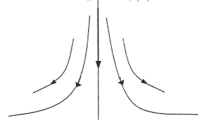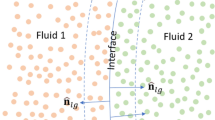Abstract
The problem of numerical modelling water purification from iron impurities is considered. The cleaning task is relevant for many industrial applications, including the development of new cleaning methods and devices for the preparation of ultrapure water. The performed mathematical study is associated with the calculations of the water flow and the transfer of contaminants in the treatment system for real geometry. In the work, a new numerical approach to solving the problem is proposed; the corresponding calculated data are obtained. The analysis of the results showed that they have a good agreement with the calculation results of the ANSYS CFD package.



Similar content being viewed by others
REFERENCES
T. A. Kudryashova, S. V. Polyakov, D. V. Puzyr’kov, and N. I. Tarasov, Mathematical Modeling of Water Purification from Iron Compounds (Ross. Akad. Nauk, Moscow, 2017) [in Russian].
S. V. Polyakov, T. A. Kudryashova, Yu. N. Karamzin, and N. I. Tarasov, Math. Montisnigri 40, 110–126 (2017).
P. J. Roache, Computational Fluid Dynamics (Hermosa, Albuquerque, 1976).
S. M. Richardson and A. R. Cornish, J. Fluid Mech. 82 (2), 309–319 (1977).
S. M. Richardson, Doctoral Dissertation (Department of Chemical Engineering and Chemical Technology, Imperial College of Science and Technology, London, 1976).
S. G. Gegg, “A dual-potential formulation of the Navier–Stokes equations,” Retrospective Theses and Dissertations (1989). https://lib.dr.iastate.edu/rtd/9040
L. D. Landau and E. M. Lifshitz, Fluid Mechanics (Nauka, Moscow, 1986; Butterworth-Heinemann, Oxford, 1987).
R. Eymard, T. R. Gallouet, and R. Herbin, The Finite Volume Method: Handbook of Numerical Analysis (North Holland, Amsterdam, 2000), Vol. 7, pp. 713–1020.
S. V. Polyakov, Math. Montisnigri 26, 29–44 (2013).
T. Kudryashova, S. Polyakov, and N. Tarasov, “Application of the double potential method to simulate incompressible viscous flows,” in Computational Science, Ed. by J. Rodrigues (Springer, Cham, 2019).
A. A. Samarskii and E. S. Nikolaev, Numerical Methods for Grid Equations (Nauka, Moscow, 1978; Birkhäuser, Basel, 1989).
P. V. Matyushin, Math. Model. 30 (11), 44–58 (2018).
S. B. Koleshko, Yu. V. Lapin, and Yu. S. Chumakov, High Temp. 43 (3), 429–440 (2005).
V. A. Gushchin and P. V. Matyushin, Comput. Math. Math. Phys. 56 (6), 1034–1047 (2016).
A. J. Chorin, J. Comput. Phys. 135, 118–125 (1997).
Author information
Authors and Affiliations
Corresponding author
Rights and permissions
About this article
Cite this article
Polyakov, S.V., Kudryashova, T.A. & Tarasov, N.I. Double Potential Method for Modeling the Internal Flow of a Viscous Incompressible Liquid. Dokl. Math. 102, 418–421 (2020). https://doi.org/10.1134/S1064562420050397
Received:
Revised:
Accepted:
Published:
Issue Date:
DOI: https://doi.org/10.1134/S1064562420050397




